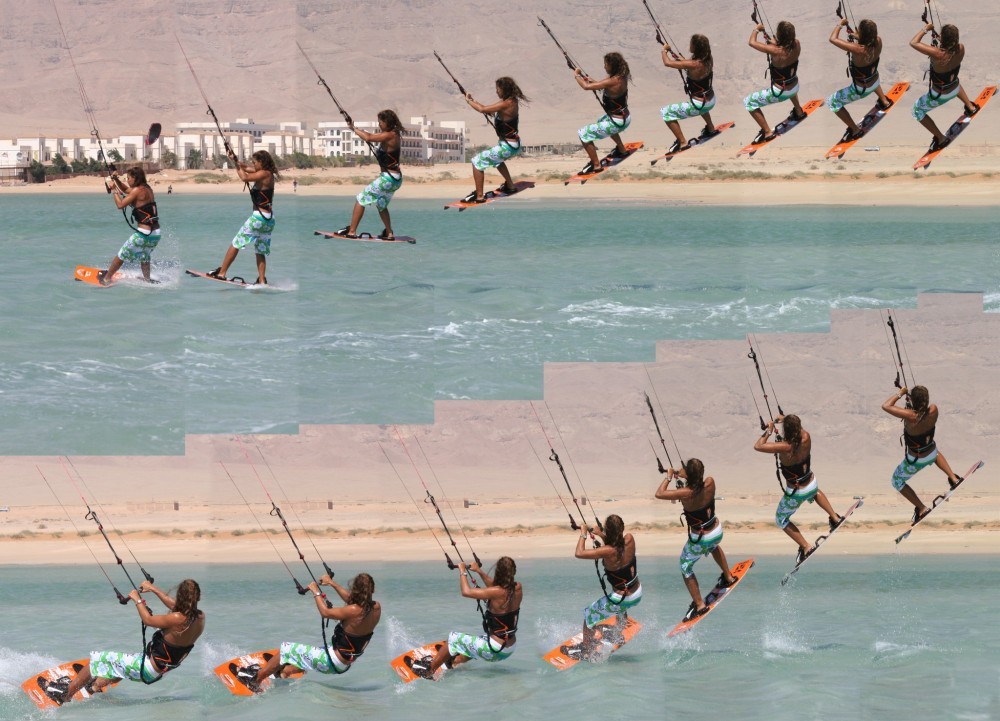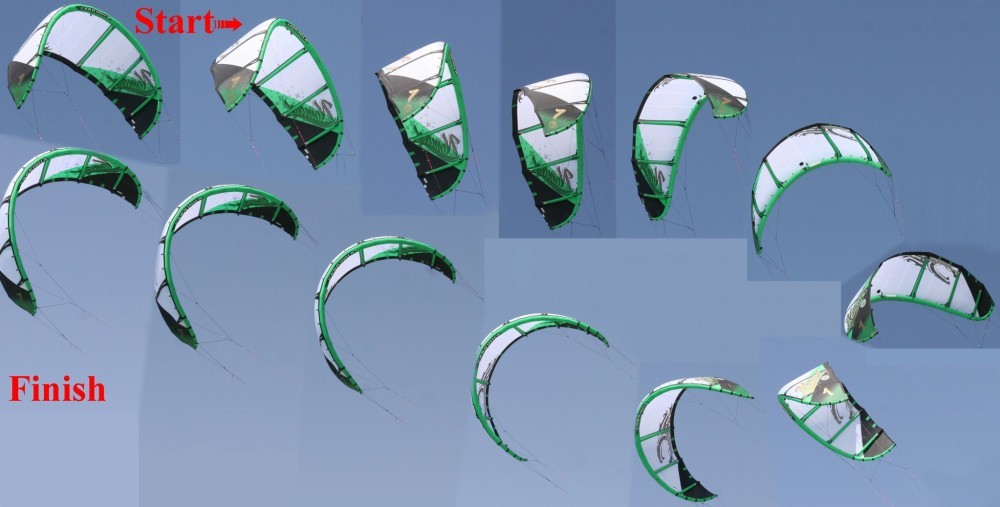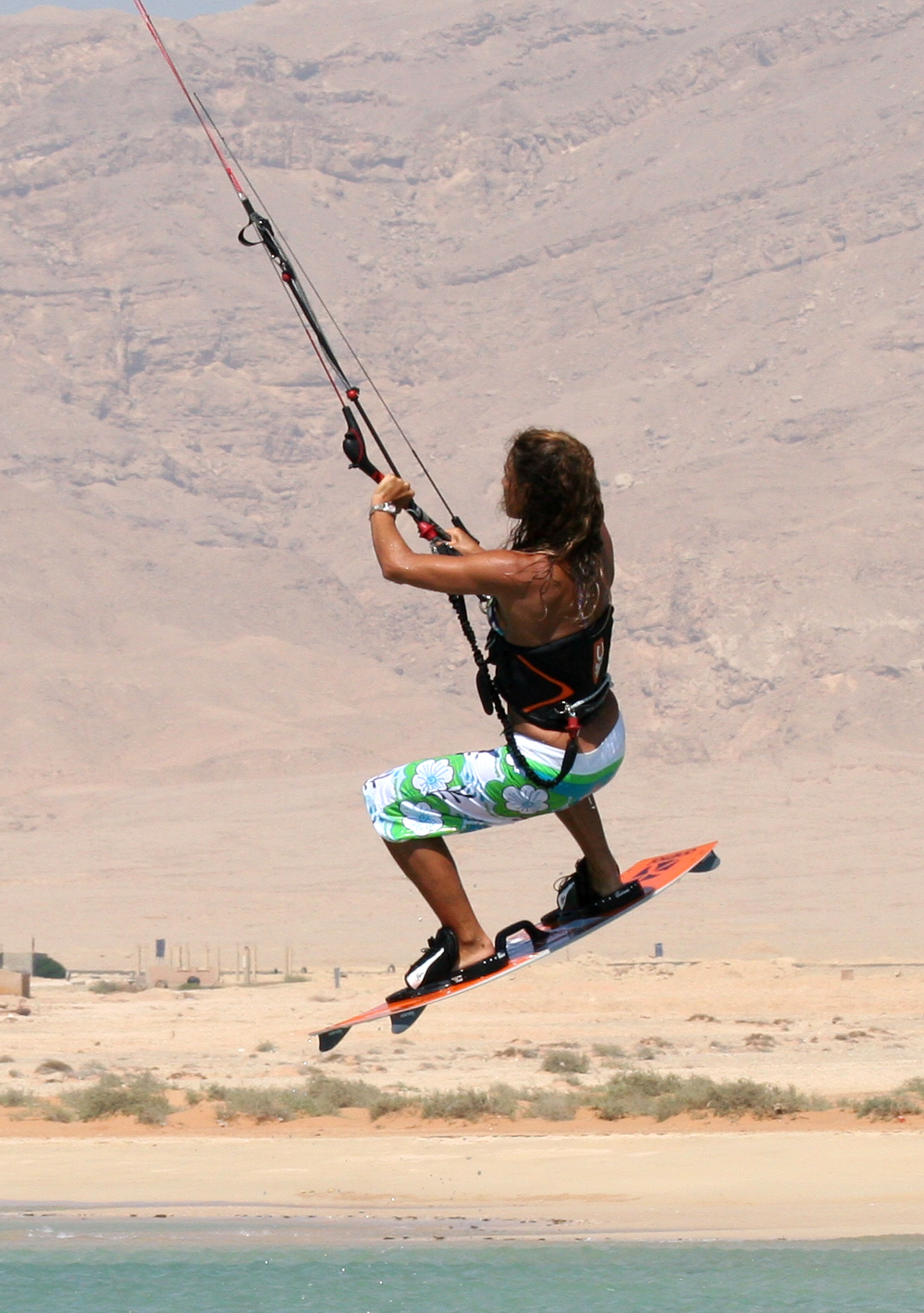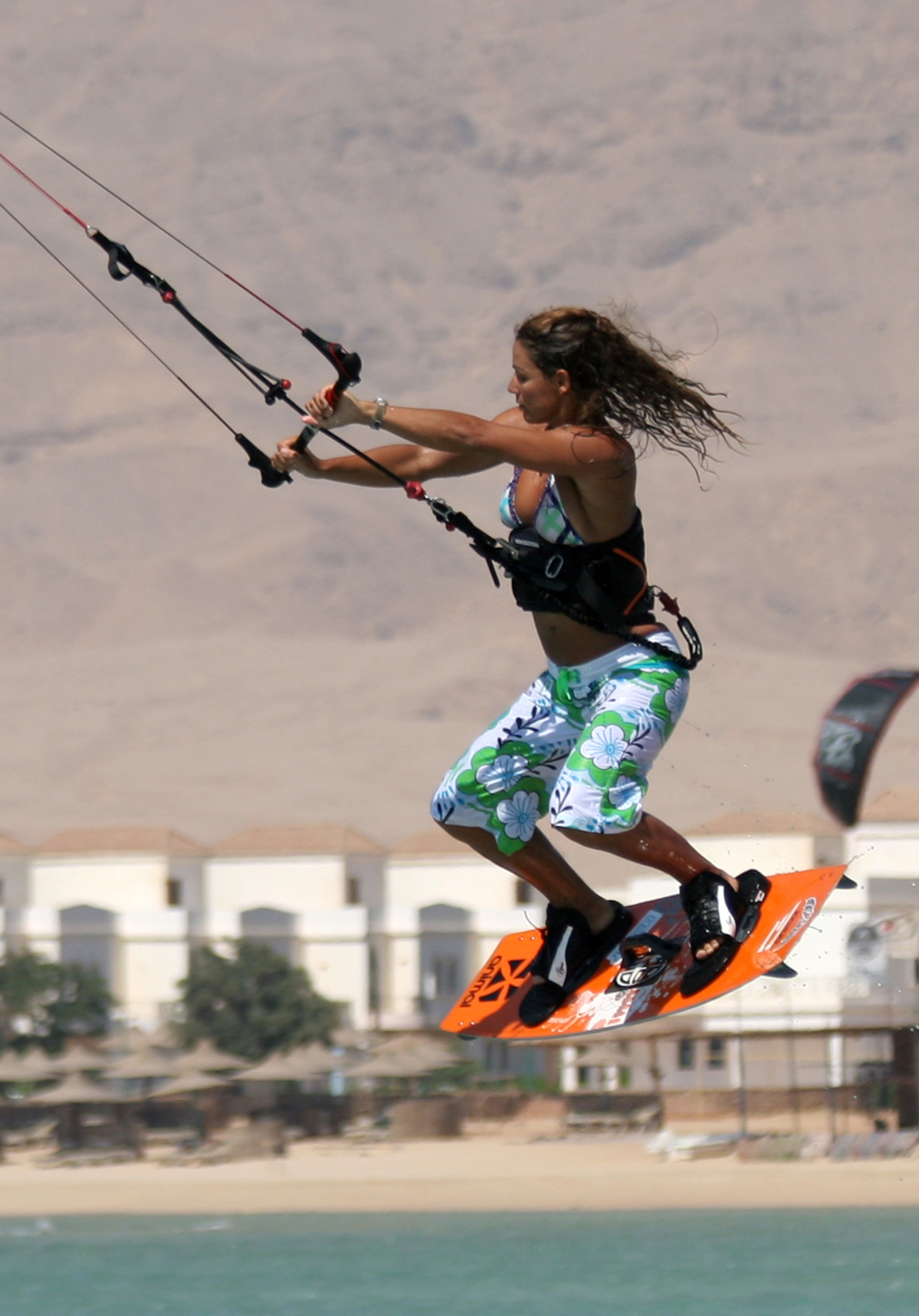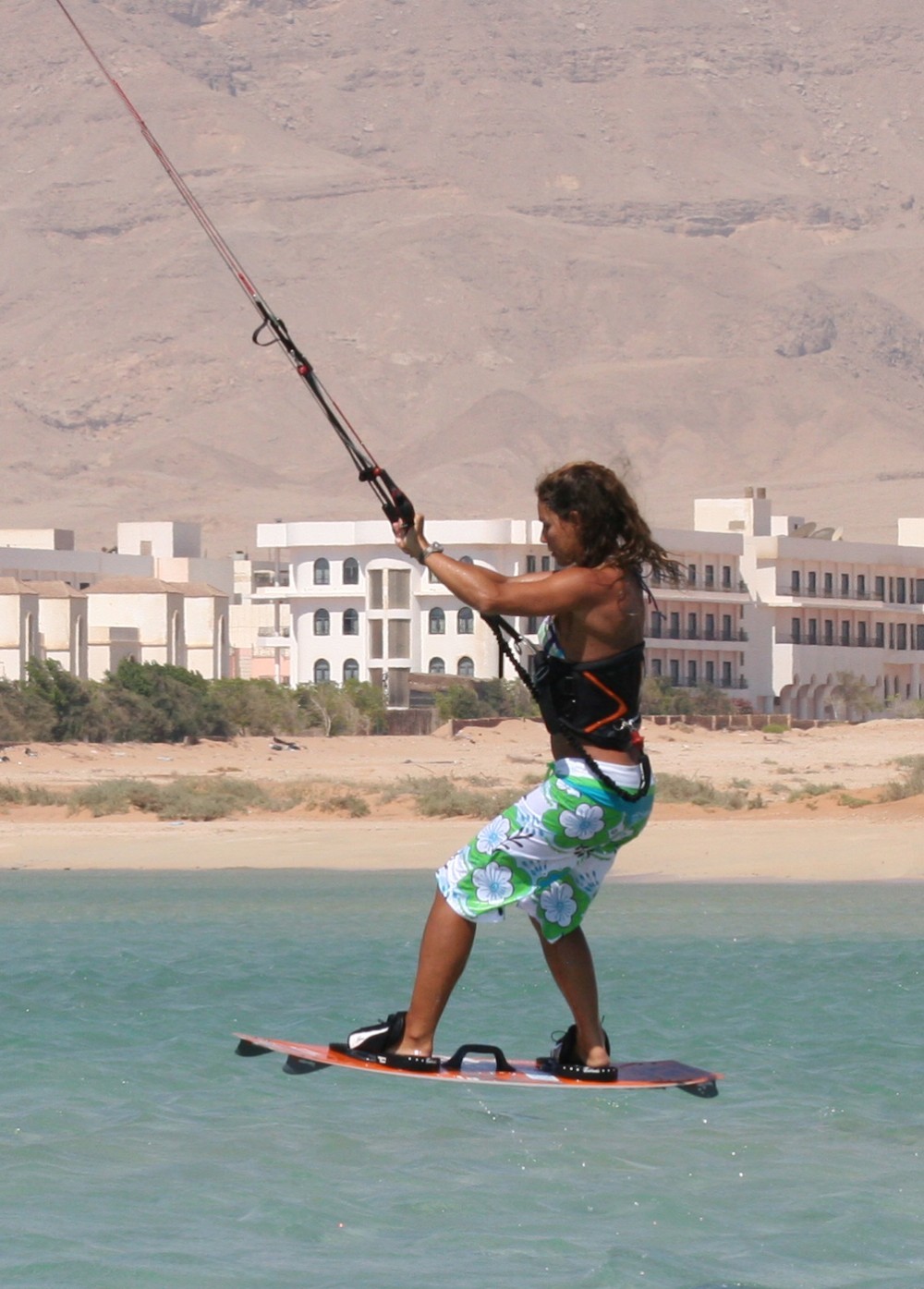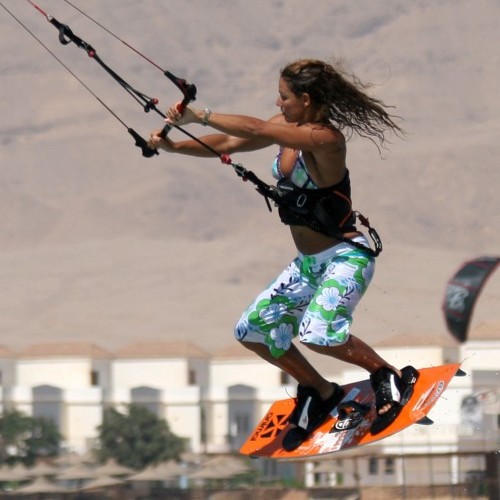
Down Loop Air Gybe
Technique / Intermediate
Introduction
Transitions may not be the coolest thing in competitions, but for most of us they are a decent opportunity to actually do something at the end of a run, which yielded no rewards. Whether it be slashing around a carve, popping into a rotation or just getting some daylight under your fins changing direction is fun and shows your peers what you’re really made of.
To get your teeth into this move you’ll want to be happy jumping, air gybing, under turning on the water, and if you’ve got some experience of landing at speed it stand you in good stead. Yet again this is really an add on, so if you’ve got the afore mentioned skills it’s really very possible.
The down loop air gybe as seen demonstrated by Karine in Video 1 is basically an air gybe, but entered with a bit more speed, and then rather than freeze and dive the kite back from whence you came, you under-turn the kite whilst still airborne. In practical terms this is brilliant as the mechanics of the move mean that you’ll land with speed. It’s also a very useful way of adding a transition as an afterthought to a jump.
Just the 3 of them
If we just wanted to decide on the two most critical parts of the downloop air gybe, they would be the commitment to the actual downloop of the kite, the landing, and the timing.
1. In Pic A we can see Karine initiating the downloop. She has her bar pulled all the way in. This way with tension on the lines the kite will do what she wants it to and when she wants it to. So when Karine decides that it’s time to downloop the kite, the kite will respond and turn. Karine also has her original front hand; her right, forward on the bar to get maximum leverage, and ensure that the kite turns quickly. In these pictures she’s very powered up on a 7m, so she doesn’t want the kite sneaking low into a very powerful loop. Finally she is not turning the kite into the downloop, but rather diving it in. Karine is pulling with all her strength on her right arm, not steering it with finesse.
At this time you should really try and look where you think you’ll land. It will be pretty much directly downwind of you. If you look downwind with your eyes, your head and body will follow and you’ll keep your balance.
By committing to an aggressive turn, the pull from the kite, when it comes will be short lived. As soon as the kite starts to rise the pull will disappear and Karine will come down. From the extra bit of speed she has gained, Karine will be able to secure a soft landing, but more on that later.
It’s worth remembering that because you are turning the kite with your direction of travel in a downloop, the resultant force is less than that of a kiteloop, when the kite pulls back against your direction of travel. In short a downloop has far less chance to spank you, so long as you commit.
We’ve included Pic B to show the most common mistake of all, the absolute antithesis of committing to the downloop. As the power has come on, Karine has let the bar be pulled out. With less, or no tension on the back lines the kite will no longer turn, so it’ll take a long swing down, generating a lot of power. Also because it doesn’t turn under and go back the other way Karine is pulled forward, so her body position is all wrong. She will now have to suffer the consequences, a nice cooling dip from the 40˚ wind!
2. Pic C shows you the perfect landing scenario. Knowing that Karine will be riding away from this to her left, you can see that she has her left foot forward, with the board pointing fairly down wind. She has let the board drop underneath her and has extended her legs. This means that she will be over the board, and can absorb the impact of landing without falling to windward, and with the board pointing downwind she can land with all the speed she likes on a flat surface, rather than skipping out on an edge. She is totally fixed upon where she will land, which will help her anticipate the touch down and keep her balanced.
Looking at her kite lines you can see that the kite is definitely on its way back up, which means there is no more pull, but it will be supporting Karine and parachuting her back down. If she has a lot of speed she will need to dive the kite back down to the left to keep the tension on the lines. Once you have this nailed and have some mileage you’ll know when to stop pulling so that your kite just pulls you out and away, but at the begging if it goes all the way back up at least you conquered the downloop.
3. The timing of the downloop is critical to the success of this move. At the beginning you’re much better off being too late rather than too early. As a rule of thumb if you pull like a banshee on your front hand as soon as you feel yourself coming down, you can’t go too far wrong. Obviously if you pull too late, you’ll land and then loop the kite, more of an air gybe to under turn, but it’s a start. However if you pull as soon as you take off, you’re expecting the kite to come down as you go up, so the result will be more hectic. Fun if you want it but best left until that time.
Following Sequence 1
- Pic 1. Having checked to see that she’s got plenty of room down wind of her Karine approaches with a bit more speed than for an air gybe. This extra speed will make the down loop smoother.
- Pic 2. Karine sends the kite back to get some air and edges hard upwind.
- Pic 3. As with an air gybe Karine will want to help herself get airborne, so she bends her back leg slightly in anticipation of jumping up.
- Pic 4. As soon as she feels the kite lift Karine does 2 things. She springs up off her back leg. And she immediately redirects the kite. By getting the kite moving forward early on the downloop will be smoother and the kite will be ready for Karine’s command.
- Pic 5. As the kite lifts Karine she keeps the bar in and waits.
- Pic 6. As Karine feels she’s reaching the apex of her jump she moves her front, right, hand forward to the end of the bar. For your first attempts you might want to do this before you go into the move.
- Pics 7, 8 & 9. Now at the apex of her jump Karine pulls like a woman possessed with her front hand. She has her bar pulled/sheeted all the way in and has really yanked down on her right hand so that its pulled right in to her body.
- Pic 10. As the kite loops it pulls Karine downwind. She keeps herself balanced by bringing her knees up, which stops her feet and board being “left behind”. She’s still got the bar in and is still turning the kite.
- Pic 11. The kite has now come through the bottom of its turn and is on the way back up, which results in Karine dropping back down towards the water.
- Pic 12. As she does Karine stops pulling on her right hand, but still keeps the bar in to keep the kite powered with tension in the lines. With the downwind momentum from the kite’s pull Karine knows where she’ll land, so she concentrates on her chosen/given spot.
- Pic 13. Just before touchdown, Karine drops her legs and board underneath her and points the board off the wind.
- Pic 14. This results in a beautiful tail first landing onto a stable platform, enabling Karine to soak up the speed. Karine is also pulling on her left hand to dive the kite down in front of her. This is often needed when using a small kite.
- Pic 15. Karine lands and carves back up wind to regain control of the kite and get back onto an edge. If she spent too long running downwind she would chase her kite and get a lot of slack in the lines.
The Kite
Sequence 2 shows you the movement of the kite. The first picture shows the kite going up from take off. It then immediately moves forward, before it is dived into the downloop. As it goes down and comes around it generates the short burst of power, but as soon as it starts climbing peace is restored.
Note: all the kite movement will/should be happening way above your head. If the kite starts at 12 o’clock and you pull hard, it will turn up there in the heavens and reward you with a graceful and angelic transition.
Common Problems
As we’ve already mentioned letting the power of the downloop pull the bar out is a classic, but at least the remedy of keeping the bar in is a simple mind over matter solution. If your kite is not turning quick enough it’s either this or your not pulling hard enough with your front hand at the end of the bar.
If you find the opposite, that your kite is turning too quickly, well done. If this is the case try watching your kite and as it starts to steer it up and across the window, so that it pulls you out of the move in the direction you want to go.
If you’re landing on an edge, and not pointing the board downwind. Often happens because you’re trying this on you favourite jumping side, but as you’re landing going the other way it may not be your preferred landing. If this is the case try landing toe side, with your favoured foot pointing downwind.
Keystones
- Jump with some speed and redirect the kite
- Move front hand to end of bar
- Pull like crazy
- Look where you’ll be going
- Point board downwind
This technique article was in Issue 16 of IKSURFMAG.
Related
By Christian and Karine
Christian and Karine have been working together as a coaching team, running improver to advanced kitesurfing clinics since 2003.




